Critias › Croesus › Early Jericho » Origins and History
Articles and Definitions › Contents
- Critias › Who Was
- Croesus › Who Was
- Early Jericho › Origins
Ancient civilizations › Historical places, and their characters
Critias › Who Was
Definition and Origins
Critias (c. 460-403 BCE) was an Athenian politician who, earlier in life, was one of Socrates ' followers and Plato ’s mother's cousin. One of the hated “Thirty Tyrants” of Athens, Critias was held in especially low esteem for his practice of confiscating citizen's property by mis-using his power and executing those who disagreed with or challenged him. The Thirty Tyrants (or The Council of Thirty) were a pro-Spartan oligarchy who were installed in power by the Spartan General Lysander following Athens defeat by Sparta in the Peloponnesian War in 404 BCE. The Thirty Tyrants severely limited the rights and freedoms of the citizens of Athens and, most notably, their right to vote as well as showing little scruple in having their opponents executed or exiled on the slightest whim. Of the thirty men who comprised this council, Critias was the most ruthless.
PRIOR TO HIS DARK HISTORY AS A POLITICIAN, CRITIAS WAS A WRITER OF TRAGEDIES AND ELEGIES.
His known association with Socrates no doubt did little to help the latter's case in court in 399 BCE (when Meletus, Anytus and Lycon charged Socrates with impiety and corrupting the youth of Athens). Prior to his dark history as a politician, Critias was a writer of tragedies and elegies and was highly praised for his prose works. That he should descend from the role of artist to tyrant no doubt furthered the suspicion among the Athenians that some corrupting force must have exerted itself on the young man to drive him to such excess in cruelty and villainy and that 'force' seemed to them to be Socrates.
Unlike Protagoras, who claimed the subject of whether gods existed could not properly be known by a man, Critias claimed there were no gods and that, further, the gods were merely a construct created by man to control other men. In Critias' view, “A time there was when anarchy did rule/the lives of men” and the laws which were created by men to control society simply were ineffective. So “some shrewd man first, a man in counsel wise / Discovered unto men the fear of the Gods / Thereby to frighten sinners should they sin” and so the gods came to be the higher authority which would reward or punish people for what they did “secretly in deed, or word, or thought.” Critias was killed in battle near the port of Piraeus, outside Athens, in 403 BCE in the conflict which ended the rule of the Thirty Tyrants.
Unlike Protagoras, who claimed the subject of whether gods existed could not properly be known by a man, Critias claimed there were no gods and that, further, the gods were merely a construct created by man to control other men. In Critias' view, “A time there was when anarchy did rule/the lives of men” and the laws which were created by men to control society simply were ineffective. So “some shrewd man first, a man in counsel wise / Discovered unto men the fear of the Gods / Thereby to frighten sinners should they sin” and so the gods came to be the higher authority which would reward or punish people for what they did “secretly in deed, or word, or thought.” Critias was killed in battle near the port of Piraeus, outside Athens, in 403 BCE in the conflict which ended the rule of the Thirty Tyrants.
Croesus › Who Was
Definition and Origins
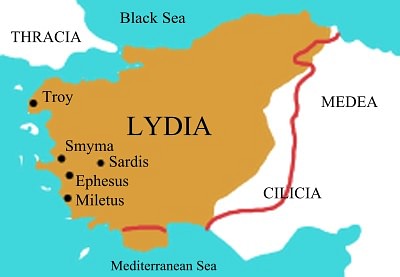
Croesus (pronounced 'KREE-sus') was the King of Lydia, a country in western Asia Minor (corresponding to modern-day Turkey ) from 560-547 BCE and was so wealthy that the old expression "as rich as Croesus" originates in reference to him.His wealth, it is said, came from the sands of the River Pactolus in which the legendary King Midas washed his hands to rid himself of the 'Midas Touch' (which turned everything he laid hands on into gold ) and in so doing, the legend says, made the sands of the river rich with gold. The Lydians, either during the reign of Croesus or just before, were cited as the first people to mint coins of gold and silver in Asia Minor and it was Croesus who funded construction of the great Temple of Artemis at Ephesus, one of the Seven Wonders of the ancient world. Although some have claimed that Croesus was largely a legendary figure, his signature at the base of one of the columns of the Temple of Artemis (now on display at the British Museum) is evidence that he was an actual historical king who ruled from the city of Sardis.
IT WAS CROESUS WHO FUNDED CONSTRUCTION OF THE GREAT TEMPLE OF ARTEMIS AT EPHESUS, ONE OF THE SEVEN WONDERS.
Although Croesus is mentioned by Xenophon and Ctesias, among others, two of the most famous stories regarding him come from the Histories of Herodotus (1.29-45 and 1.85-89). The first has to do with the great Athenian lawgiver Solon the Wise.Solon travelled throughout Anatolia and down to Egypt and came, at last, to the palace of Croesus at Sardis. Croesus was overjoyed to have so illustrious a visitor and was anxious to show off his treasuries and, after Solon had inspected them, asked him who, of all the men he had met in his travels, he would call the most happy. Solon answered, “Tellus of Athens.” Croesus, upset that he himself had not been named, asked why Tellus. Solon answered that Tellus had lived well and happily, had a beautiful family, and had died gloriously for Athens in battle. Croesus, conceding this was a good life, and hoping he would at least be named second, then asked Solon who else he would consider the happiest of men he had met; Solon answered:
The brothers Cleobis and Bito of the Argive race” and explained why, noting again a life well lived and a good death. Croesus, angered now, shouted: "Man of Athens, am I not the happiest man in the world? Dost thou count my happiness as nothing?" Solon replied calmly: “In truth, I count no man happy until his death, for no man can know what the gods may have in store for him. He who unites the greatest number of advantages, and retaining them to the day of his death, then dies peaceably, that man alone, sire, is in my judgment entitled to bear the name of 'happy.' But in every matter it behooves us to mark well the end: for oftentimes God gives men a gleam of happiness, and then plunges them into ruin.
Croesus sent Solon away, thinking his reputation for wisdom overrated, but would soon learn the truth of what Solon had said through the events narrated by Herodotus' second story. The first misfortune to come upon Croesus was the death of his son Atys, killed while hunting a boar in Olympus (and, ironically, killed by the man whom Croesus had sent on the hunt for the express purpose of keeping Atys safe). Croesus grieved for his son for two years until he was alerted that the Persians under Cyrus were gaining power and decided he should check them sooner rather than later.
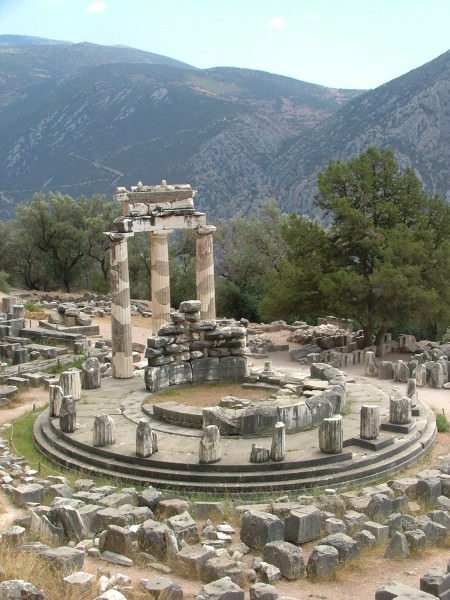
Tholos of Delphi
He sent to the great Oracle at Delphi to know whether he should go to war against the Persian Empire and the oracle replied: "If Croesus goes to war he will destroy a great empire." Pleased by this answer, Croesus made his necessary alliances and preparations and went out to meet the Persian army at the Halys River (which Thales of Miletus, an engineer in his corps, helped him to cross by diverting the waters). The battle at the Halys was a draw and Croesus marched his force back to Sardis where the army was disbanded for the winter. Croesus expected Cyrus to do the same, as this was customary, but Cyrus instead pressed the attack, massacred Croesus' cavalry in the field by mounting his own cavalry on dromedaries (whose scent frightened the Lydian horses) and captured Croesus. After the fall of Sardis, Croesus' wife committed suicide and Croesus was dragged before Cyrus in chains.
For daring to raise an army against the Persian Empire, Cyrus ordered Croesus to be burned alive along with fourteen noble Lydian youths. When Croesus saw the flames of the pyre lapping toward him, he called out for aid from Apollo to rescue him and a sudden rain shower broke overhead and put out the fire. Croesus was saved from burning to death but was still the captive of the Persian King and, remembering the words of Solon the Wise, cried out, "O Solon! Solon! Solon!" Cyrus asked a translator what this word meant and Croesus told the story of Solon's visit, how no man can be counted happy until after his death, and further, of how he was misled by the Oracle at Delphi who had told him that if he went to war against Cyrus he would 'destroy a great empire' and here the 'great empire' destroyed had been his own, not that of Cyrus.
For daring to raise an army against the Persian Empire, Cyrus ordered Croesus to be burned alive along with fourteen noble Lydian youths. When Croesus saw the flames of the pyre lapping toward him, he called out for aid from Apollo to rescue him and a sudden rain shower broke overhead and put out the fire. Croesus was saved from burning to death but was still the captive of the Persian King and, remembering the words of Solon the Wise, cried out, "O Solon! Solon! Solon!" Cyrus asked a translator what this word meant and Croesus told the story of Solon's visit, how no man can be counted happy until after his death, and further, of how he was misled by the Oracle at Delphi who had told him that if he went to war against Cyrus he would 'destroy a great empire' and here the 'great empire' destroyed had been his own, not that of Cyrus.

Lydian Gold Stater
Early Jericho › Origins
Ancient Civilizations
The city of Jericho is remembered for the story in the Book of Joshua in the Bible regarding its destruction by the Israelites.Excavations have revealed that Jericho is one of the earliest settlements dating back to 9000 BCE. It also has the oldest known protective wall in the world. Continuing excavations have revealed stone towers which are even older. The reason for its earliest settlements are the springs which are found in and near the city. These springs supply the area with enough water to sustain a large population. We are going to cover the settlement of Jericho from its earliest beginnings until The Battle of Jericho in the Bible.
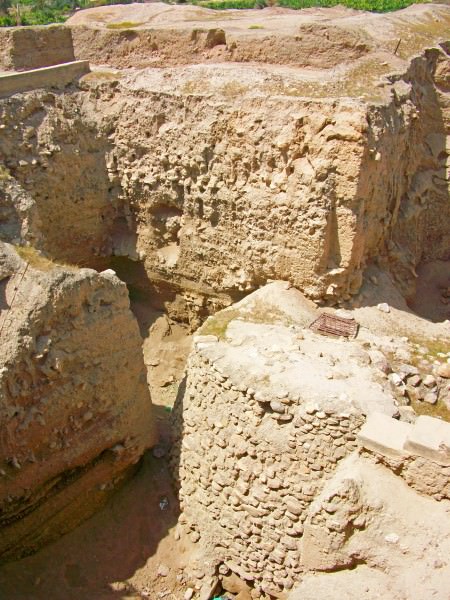
Walls of Jericho
FIRST SETTLEMENT
Jericho started as a popular camping ground for the hunter-gathers of the Natufian culture dating to 10000 BCE. It wasn't until the cold and drought caused by the last Ice Age, or Younger Dryas, came to an end around 9600 BCE that year-round habitation and permanent settlements began in the area. Tell es-Sultan (Sultan's Hill), 2 kilometers (1.2 miles) north of modern-day Jericho, became the earliest permanent settlement. It was a Pre- Pottery Neolithic (New Stone Age ) settlement. It is situated on the Ein as-Sultan spring (later called Elisha's Spring) supplying it with water. By about 9400 BCE the settlement grew to include more than 70 homes. These circular dwellings measured 5 meters (16 feet) in diameter and were built with clay and straw.
ARCHAEOLOGICAL EVIDENCE REVEALS THAT JERICHO, BY 8000 BCE, WAS SURROUNDED BY A STONE WALL 3.6 METERS HIGH & 1.8 METERS WIDE.
THE WALL OF JERICHO
Archaeological evidence reveals that by 8000 BCE, the site grew to 40,000 square meters (430,000 square feet) and was surrounded by a stone wall 3.6 meters (11.8 feet) high and 1.8 meters (5.9 feet) wide at the base. Inside the wall was a stone tower 8.5 meters (28 feet) high and 9 meters (30 feet) wide at the base. The tower had an internal staircase with 22 steps. The only older towers than this one have been found at Tell Qaramel in Syria. It is thought that the wall was used to protect the settlement from flood waters. The tower was used for ceremonial purposes. This suggests that there was a social organization happening in the town. Some scholars believe that the tower was used to motivate people into taking part in the communal lifestyle. Estimates vary on the population with a low of 300 to a high of 3000. At this time the inhabitants domesticated wheat, barley and legumes. It is highly probable that irrigation had been invented to provide enough land for the cultivation of these crops. They supplemented their diet by hunting wild animals.
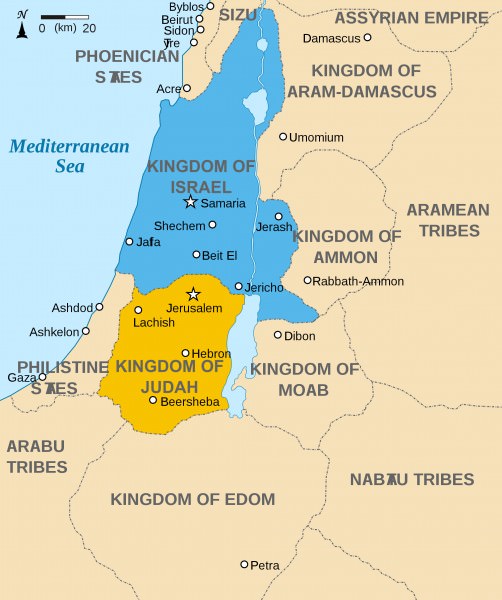
Map of the Levant circa 830 BCE
THE SECOND SETTLEMENT
After a few centuries, the first settlement was abandoned. Around 7000 BCE, a second settlement was established by an invading people that absorbed the original inhabitants into their culture. It too was a Pre-Pottery Neolithic settlement. This new settlement expanded the range of domesticated plants. There is evidence for the possible domestication of sheep at this time.Buildings were rectilinear structures made of mudbricks. Each building consisted of several rooms situated around a central courtyard. The rooms had terrazzo floors made of lime and the courtyard had a floor made of clay. Other advancements include flints in the shape of arrowheads, sickle blades, burins (used as chisels), scrapers, and axes. Also found were grindstones, hammerstones, and axes made of greenstone. Dishes and bowls were carved from soft limestone. The greatest distinction of this culture was that they kept the heads of deceased relatives by plastering the skulls and painting the features of the person on it. These skulls were kept in the home and the rest of the body was buried. This settlement lasted until about 6000 BCE. There is then little evidence of occupation at Jericho for at least 1000 years.
BRONZE AGE & THE FALL OF JERICHO
After this, new settlements were established in Jericho periodically. These settlements were still Neolithic, but there is evidence that they were producing pottery. It became a walled town again at the end of the 4th millennium BCE. Evidence shows that the walls have been rebuilt many times. The largest of these settlements was constructed in 2600 BCE by the Amorites. About 2300 BCE, there was once more a break in the occupation of the site. It was taken over by the Canaanites in 1900 BCE and reached its greatest prominence between 1700 BCE and 1550 BCE. This was due to the rise of aristocrats that utilized chariots called the Maryannu in the Mitannite state to the north. Their rise caused a greater urbanization in the surrounding area, including Jericho. By this time, there were two walls around the city in a double enclosure made of mud brick. The outside wall rested on top of a stone base. Though they were impressive in size, they were not stable. Bronze Age Jericho fell in the 16th century around 1573 BCE when it was violently destroyed by an earthquake. Charred wood found at the site suggests that the remains of the city were burned. Buried food supplies also suggest that it was not captured following a siege. It remained unoccupied until the late 10th century or early 9th century BCE when it was rebuilt.
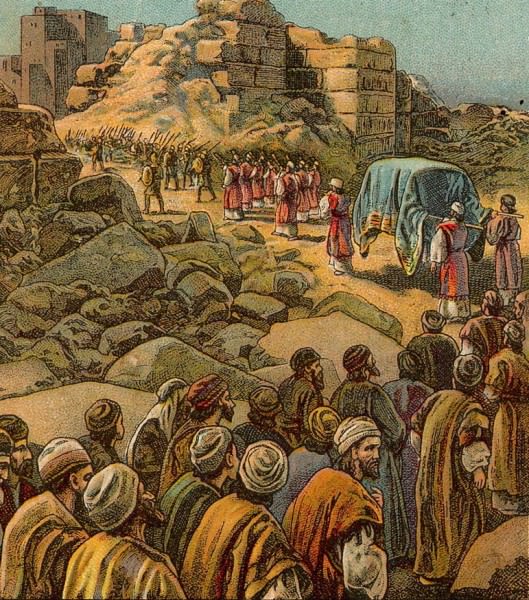
The Israelites Capture Jericho
THE ISRAELITES & THE BATTLE OF JERICHO
According to the Bible, at around 1,400 BCE, Jericho was the first city attacked by the Israelites after they crossed the JordanRiver and entered Canaan. The Wall of Jericho was destroyed when the Israelites walked around it for seven days carrying the Ark of the Covenant. On the seventh day, Joshua commanded his people to blow their trumpets made of rams' horns and shout at the walls until they finally fell down. Excavations of the site reveal a network of collapsed walls that date to around the late 17th century or early 16th century BCE. The most likely cause of the collapse was an earthquake. Descriptions of later earthquake destruction (1267 CE & 1927 CE) match the description of the collapsed walls in the Bible. In each description, the cliffs above the Jordan River fell into the river and dammed it up. It also reveals that Jericho was unoccupied from the late 15th century to around the 10th century BCE. Non-Biblical Scholars now believe that the Bible story is an allegory. The story was written sometime after 722 BCE, long after the date of the event, and was used to claim the territory for the Kingdom Of Israel. Biblical Scholars point to the destruction of the walls 175 years earlier as proof that the story in the Bible is true. They state that the only thing amiss is the dating in the Bible and that the earthquake was God rewarding the Israelites for following his commands. According to the Bible, Jericho remained abandoned until Hiel the Bethelite established himself there in the 9th century BCE.
LICENSE
Article based on information obtained from these sources:with permission from the Website Ancient History Encyclopedia
Content is available under License Creative Commons: Attribution-NonCommercial-ShareAlike 3.0 Unported. CC-BY-NC-SA License